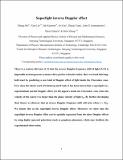Superlight inverse Doppler effect
Author(s)
Shi, Xihang; Lin, Xiao; Kaminer, Ido; Gao, Fei; Yang, Zhaoju; Joannopoulos, John D.; Soljacic, Marin; Zhang, Baile; ... Show more Show less
Download1805.12427.pdf (947.0Kb)
Terms of use
Metadata
Show full item recordAbstract
It has long been thought that the inverse Doppler frequency shift of light is impossible in homogeneous systems with a positive refractive index. Here we break this long-held tenet by predicting a previously unconsidered Doppler effect of light inside a radiation cone, the so-called Vavilov–Cherenkov cone, under specific circumstances. It has been known from the classic work of Ginzburg and Frank that a superlight (that is, superluminal) normal Doppler effect appears inside the Vavilov–Cherenkov cone if the velocity of the source v is larger than the phase velocity of light v[subscript p]. By further developing their theory, we discover that an inverse Doppler frequency shift will arise if v > 2v[subscript p]. We denote this as the superlight inverse Doppler effect. Moreover, we show that the superlight inverse Doppler effect can be spatially separated from the other Doppler effects by using highly squeezed polaritons (such as graphene plasmons), which may facilitate the experimental observation.
Date issued
2018-07Department
Massachusetts Institute of Technology. Department of PhysicsJournal
Nature Physics
Publisher
Springer Nature America, Inc
Citation
Shi, Xihang et al. “Superlight Inverse Doppler Effect.” Nature Physics 14, 10 (July 9, 2018): 1001–1005. © 2018 the Authors
Version: Original manuscript
ISSN
1745-2473
1745-2481